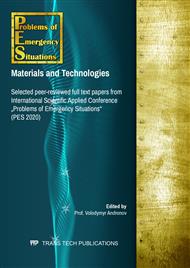p.117
p.123
p.130
p.136
p.143
p.149
p.158
p.166
p.173
Determination of Integrated Safety of High-Risk Structures According to Criteria of Acceptable and Manageable Risks
Abstract:
The paper considers the transition from traditional methods and systems for determining the standard and limit states of potentially dangerous objects by criteria of strength, resource and reliability to new perspective methods for assessing the risks of managing them. The conditions for ensuring the complex safety and security of the equipment and high-risk structures by the criteria of acceptable and managed risks are determined. It is established that the level of risk for assessing the safety status of a potentially dangerous object is defined as a probabilistic measure of the occurrence of man-made or natural phenomena, which are accompanied by the formation and action of harmful factors, as well as inflicted social, environmental, economic and other kinds of losses.
Info:
Periodical:
Pages:
143-148
Citation:
Online since:
August 2020
Price:
Сopyright:
© 2020 Trans Tech Publications Ltd. All Rights Reserved
Share:
Citation:


